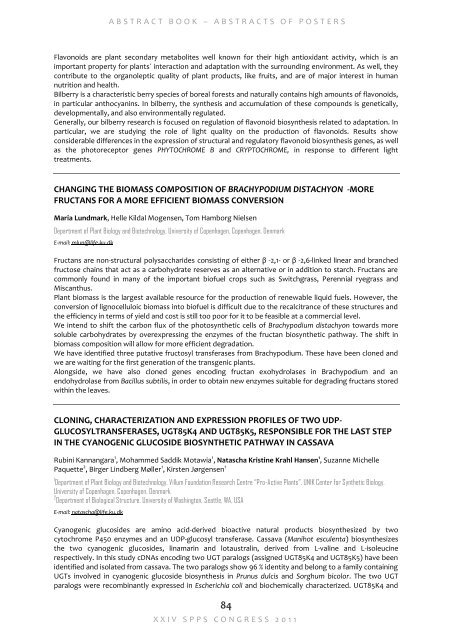1. Front Cover.cdr - CORE
1. Front Cover.cdr - CORE
1. Front Cover.cdr - CORE
Create successful ePaper yourself
Turn your PDF publications into a flip-book with our unique Google optimized e-Paper software.
A B S T R A C T B O O K – A B S T R A C T S O F P O S T E R S<br />
Flavonoids are plant secondary metabolites well known for their high antioxidant activity, which is an<br />
important property for plants´ interaction and adaptation with the surrounding environment. As well, they<br />
contribute to the organoleptic quality of plant products, like fruits, and are of major interest in human<br />
nutrition and health.<br />
Bilberry is a characteristic berry species of boreal forests and naturally contains high amounts of flavonoids,<br />
in particular anthocyanins. In bilberry, the synthesis and accumulation of these compounds is genetically,<br />
developmentally, and also environmentally regulated.<br />
Generally, our bilberry research is focused on regulation of flavonoid biosynthesis related to adaptation. In<br />
particular, we are studying the role of light quality on the production of flavonoids. Results show<br />
considerable differences in the expression of structural and regulatory flavonoid biosynthesis genes, as well<br />
as the photoreceptor genes PHYTOCHROME B and CRYPTOCHROME, in response to different light<br />
treatments.<br />
CHANGING THE BIOMASS COMPOSITION OF BRACHYPODIUM DISTACHYON -MORE<br />
FRUCTANS FOR A MORE EFFICIENT BIOMASS CONVERSION<br />
Maria Lundmark, Helle Kildal Mogensen, Tom Hamborg Nielsen<br />
Department of Plant Biology and Biotechnology, University of Copenhagen, Copenhagen, Denmark<br />
E-mail: mlun@life.ku.dk<br />
Fructans are non-structural polysaccharides consisting of either β -2,1- or β -2,6-linked linear and branched<br />
fructose chains that act as a carbohydrate reserves as an alternative or in addition to starch. Fructans are<br />
commonly found in many of the important biofuel crops such as Switchgrass, Perennial ryegrass and<br />
Miscanthus.<br />
Plant biomass is the largest available resource for the production of renewable liquid fuels. However, the<br />
conversion of lignocelluloic biomass into biofuel is difficult due to the recalcitrance of these structures and<br />
the efficiency in terms of yield and cost is still too poor for it to be feasible at a commercial level.<br />
We intend to shift the carbon flux of the photosynthetic cells of Brachypodium distachyon towards more<br />
soluble carbohydrates by overexpressing the enzymes of the fructan biosynthetic pathway. The shift in<br />
biomass composition will allow for more efficient degradation.<br />
We have identified three putative fructosyl transferases from Brachypodium. These have been cloned and<br />
we are waiting for the first generation of the transgenic plants.<br />
Alongside, we have also cloned genes encoding fructan exohydrolases in Brachypodium and an<br />
endohydrolase from Bacillus subtilis, in order to obtain new enzymes suitable for degrading fructans stored<br />
within the leaves.<br />
CLONING, CHARACTERIZATION AND EXPRESSION PROFILES OF TWO UDP-<br />
GLUCOSYLTRANSFERASES, UGT85K4 AND UGT85K5, RESPONSIBLE FOR THE LAST STEP<br />
IN THE CYANOGENIC GLUCOSIDE BIOSYNTHETIC PATHWAY IN CASSAVA<br />
Rubini Kannangara 1 , Mohammed Saddik Motawia 1 , Natascha Kristine Krahl Hansen 1 , Suzanne Michelle<br />
Paquette 2 , Birger Lindberg Møller 1 , Kirsten Jørgensen 1<br />
1<br />
Department of Plant Biology and Biotechnology, Villum Foundation Research Centre “Pro-Active Plants”, UNIK Center for Synthetic Biology,<br />
University of Copenhagen, Copenhagen, Denmark.<br />
2<br />
Department of Biological Structure, University of Washington, Seattle, WA, USA<br />
E-mail: natascha@life.ku.dk<br />
Cyanogenic glucosides are amino acid-derived bioactive natural products biosynthesized by two<br />
cytochrome P450 enzymes and an UDP-glucosyl transferase. Cassava (Manihot esculenta) biosynthesizes<br />
the two cyanogenic glucosides, linamarin and lotaustralin, derived from L-valine and L-isoleucine<br />
respectively. In this study cDNAs encoding two UGT paralogs (assigned UGT85K4 and UGT85K5) have been<br />
identified and isolated from cassava. The two paralogs show 96 % identity and belong to a family containing<br />
UGTs involved in cyanogenic glucoside biosynthesis in Prunus dulcis and Sorghum bicolor. The two UGT<br />
paralogs were recombinantly expressed in Escherichia coli and biochemically characterized. UGT85K4 and<br />
84<br />
X X I V S P P S C O N G R E S S 2 0 1 1


